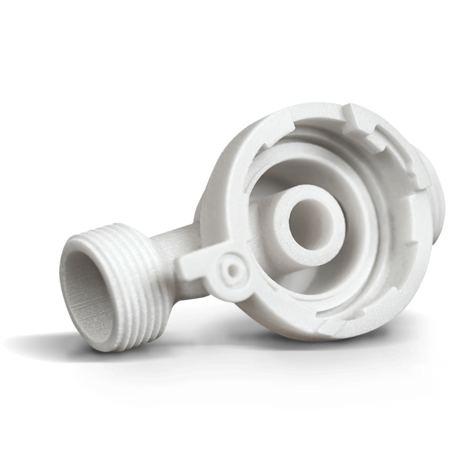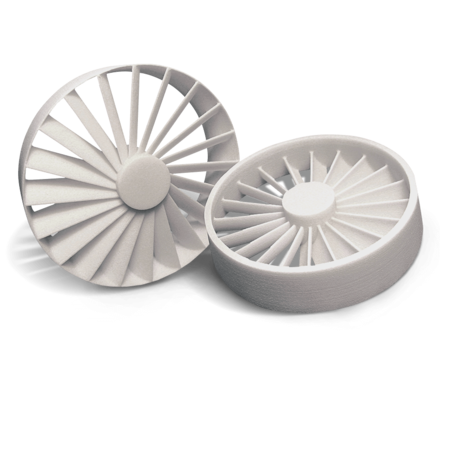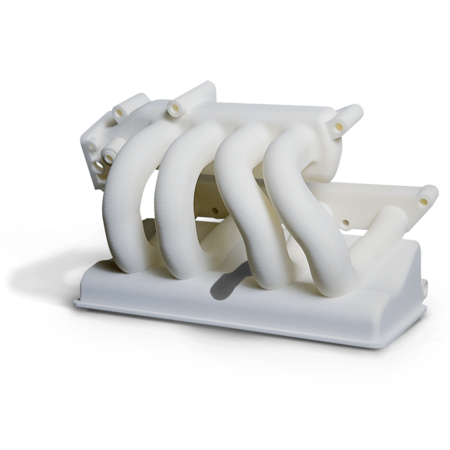American Wind uses 3D printing from 3D Systems' On Demand Manufacturing service, Quickparts, to defy 'bigger is better' argument for wind turbines.
Robert Yost can identify with Nikola Tesla, the genius inventor who advocated AC to Thomas Edison's DC electrical power. Like Tesla, Yost has a lofty vision: Using very small turbines called MicroCubes to transform the process of turning wind into electricity.
Yost's inspiration stemmed from a force of nature – a tornado that passed through northern Alabama in Spring 2011.
"My wife and I were sitting on our outdoor deck after the storm and the wind was spinning a pedestal fan like a top," says Yost. "She wanted to know why we couldn't harness electrical power from something as small as the pedestal fan."
Yost's background working for major aerospace companies such as Boeing, GE Aircraft Engines and Pratt and Whitney gave him the practical skill to follow through on the idea of a small wind turbine. He formed American Wind in February 2012 to fulfill his vision.
A major ally in Yost's quest is 3D Systems' cloud-based manufacturing service, Quickparts, which is also doing something few said could be done even half a decade ago: Manufacturing 3D-printed plastic parts and assemblies that are indistinguishable in strength, durability and flexibility to injection-molded production parts, but which can be produced in a quarter of the time.
"We've established a very good relationship between American Wind and 3D Systems Quickparts," says Yost. "3D printing allows American Wind to experiment with the right configuration for the overall design. We have made more than 20 different versions of this MicroCube, each improving upon the last.
Big power from small package
American Wind's Microcube is a 9x9x9-inch turbine that can generate power in wind speeds as slow as one mile-per-hour or as fast as 80 mph or more. It has multiple airfoils to capture more of the wind flow through the unit, improving the torque needed to generate power.
Yost isn't the first to experiment with a miniature wind turbine or even the first to combine multiple small turbines to generate greater electrical power. The difference is the design of the airfoils in the patented MicroCube and the efficiency of the electrical generator in turning out three-phase AC power.
"Other options don't work because they don't produce the amount of electricity that our unit generates," says Yost. "A U.S. patent examiner told us there has never been a generator created with the characteristics of the MicroCube. That type of efficiency makes all the difference."
Rapid concept to production
The 3D printing process and use of materials with specific qualities related to a product's functional needs enables American Wind to trim days, even weeks, off product development times. Quickparts can produce high-quality, durable, fully testable parts directly from CAD files with no tooling required.
"Quickparts enables us to use 3D printing to explore what works and what doesn't work on a production part," says Yost. "We can make multiple changes and print those changes without investing thousands of dollars in molds or machining parts out of expensive materials.
"We were able to short-circuit the process from concept to design to prototype to low-rate production in one quarter of the time it would have taken with a more traditional design-to-manufacture process."
Through ongoing experimentation and fine tuning, American Wind and Quickparts settled on 3D Systems' precise, robust Selective Laser Sintering (SLS) 3D printing and three different materials, also by 3D Systems, for the MicroCube:
- DuraForm polyamide (PA) output is used for most of the assemblies. It is ideal for parts requiring superior surface finish and fine details.
- DuraForm glass-filled (GF) is used for the generator units due to the increased strength of the material and high heat resistance. It can handle temperatures up to 135°C for extended periods of time, according to 3D Systems.
- DuraForm HST Composite is used for the wind turbine blades because of its high stiffness and thermal resistance.
Faster design validation
Yost cites several improvements he has been able to make by using 3D printing to rapidly generate new prototypes based on his design iterations:
- Designing a smaller MicroCube case for more efficient 3D-print manufacturing.
- Improving assembly processes and functionality for the stator, the stationary portion of the generator.
- Defining multiple magnets and clearance requirements between rotor and stator.
- Optimizing wire routing within the case and between stators.
- Determining optimum material use among the stators, rotors and bearings.
- Maximizing spool configuration and assembly processes for the magnetic wire that creates electricity.
"Quickparts is how most of my designs are validated," says Yost. "After the designs are completed, we use Quickparts' cloud-based quoting process to determine cost and feasibility of the design. Once we find the optimum design/cost comparison, we can easily turn the manufacturing over to Quickparts."
Learning from each other
The collaboration between American Wind and Quickparts has enabled both parties to become more efficient in material choices and manufacturing processes, according to David Fisher, a project manager for Quickparts.
"Robert has gotten to the point where he is basically setting up his own builds in the SLS machine, grouping individual files into a cluster of one part," says Fisher. "We had discussions on where certain geometries will work best in the build chamber; like round rings should be centered in the build chamber for best results and stacked parts should be staggered to help with heat dissipation. Information about build chamber size allows Robert to maximize available space when designing parts."
Coast to coast without recharging
The first object to be transformed by American Wind's MicroCube is a Ford C-Max Energi electric car. American Wind has installed four MicroCubes on the roof of the car, generating 2,800 watts per hour to keep its lithium-ion battery charged while driving. Yost's goal is to travel across the United States and back without ever plugging in the car's battery for a recharge.
During his journey Yost will also demonstrate what he calls a Wind Wall, an assembly of MicroCubes that could be placed in housing or industrial environments to generate power more efficiently without littering the environment with huge wind turbines.
Personalizing the challenge
With new designs in hand and his partially wind-powered car poised to take off across the U.S., Yost is raring to take on doubters and fulfill his mission of creating a cost-effective power alternative that doesn't deplete precious natural resources.
"Yes, I've heard all the critics state that this is perpetual motion, which can't be done," he says. "We also hear that wind turbines cannot produce enough energy in such a small form factor as the MicroCube. We are not breaking any physics laws with the MicroCube, but we are pushing the limits of what is known today. And we have the test results to prove it works."
When asked why he is the one taking on this challenge, Yost offers a simple answer worthy of Tesla: "If I don't do it, who will?"


